A person does not always like the shape of his nose, he tries to find a solution to this problem. He is faced with a choice: to have an operation or to resort to a more gentle method of rhinoplasty. Let us consider in more detail the features of a non-surgical method of nose correction, indications and contraindications for this procedure, as well as possible complications.
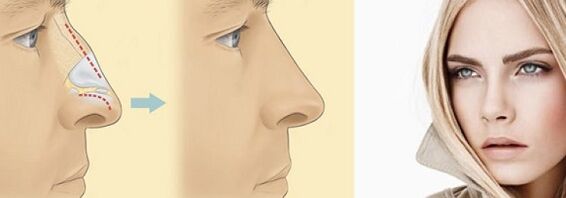
Peculiarities
Non-surgical plastic is a safe, simple method. It does not require significant, both time and financial costs, the patient does not need anesthesia. Recently, it is gaining more and more popularity due to its availability and efficiency. A special substance is injected into the correction zone, which is called a filler. It acts as a kind of implant. With the help of such rhinoplasty, you can remove the bump or fossa on the nose, make it even. But you won't be able to shrink your nose.
Before the procedure, you need to consult with a dermatologist, who will help determine if there is any allergy to the drug used. The consultation of a therapist is also needed. He must give confirmation that there are no contraindications. The surgeon who will perform the plastic surgery of the nose must first examine the patient and suggest options for materials for correction. The doctor is obliged to familiarize with the possible consequences and complications.
The procedure looks like this:
- the doctor determines the target areas;
- the patient lies down on the couch;
- a special anesthetic solution or cream is applied to his nose and cheeks (before proceeding with the correction, you need to wait 10 minutes for the drug to take effect);
- the doctor injects filler or inserts special threads.
The procedure takes no more than half an hour. After it, the patient can safely go home.
Indications for changing the shape of the nose
Correction of the shape of the nose with fillers without surgery is carried out in the following cases:
- asymmetry;
- the presence of irregularities, depressions;
- tip defect;
- flat back;
- the corners of the bridge of the nose are too sharp;
- restoration of the form after an injury or unsuccessful surgical rhinoplasty;
- sagging skin;
- an Asian or African nose that the patient does not like;
- contraindications to conventional rhinoplasty.
Drastic changes can be achieved only with the help of classical surgery. Sometimes non-surgical rhinoplasty is done in order to see the possible result after the classic surgery. The patient will be able to understand whether he likes the nose like this or not. But often this procedure is performed after surgical rhinoplasty, when small irregularities remain. The correction is recommended for those who are afraid to undergo classical rhinoplasty.
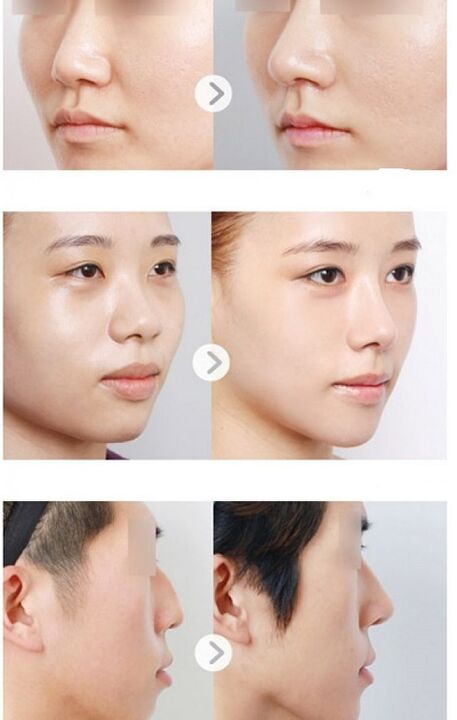
Contraindications
Although non-surgical nose surgery is a simple procedure, it has a number of limitations. We are talking about such pathologies:
- problems in the endocrine system;
- diabetes;
- oncology;
- allergy to the components of the drug used for correction;
- immune problems;
- hemophilia.
In addition to the above factors in medicine, there are a number of contraindications, eliminating which, it is possible to change the tip of the nose without surgery. These include:
- ARVI;
- pregnancy and lactation;
- cosmetic procedures (peeling and resurfacing), which were done the day before;
- period of exacerbation of any chronic ailments;
- days of menstruation;
- inflammation of the skin of the nose.
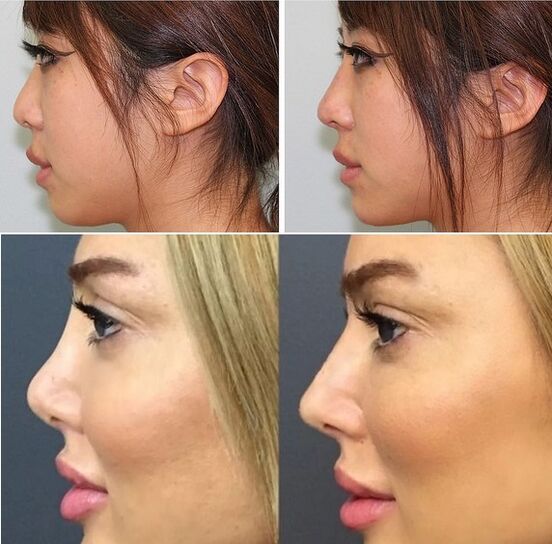
Plastic methods
Non-surgical nose surgery is performed using:
- gel fillers;
- hormonal drugs;
- mesothreads.
1. Gel filler
A special gel preparation is injected under the skin of the part of the nose that requires correction. Use the available means. The procedure is inexpensive, and there are no complications after it. But its significant drawback is a short-term effect (maximum 6 months). A second one can be carried out in six months.
Sometimes it happens that in place of the filler, which has already resolved, fibrous tissue forms. Then the nose takes on an unchanged shape. In some cases, the injected drug begins to overflow, which leads to deformation. If this happens, then the patient is shown a second procedure.
2. Use of hormonal agents
They help to remove "extra" areas that spoil the appearance. If the doctor injects more of the drug, then this can lead to excessive tissue dissolution. Therefore, the doctor requires increased care and accuracy. Changing the shape of the nose with the power of hormonal agents is carried out in several stages. Although the method gives good results, in some cases it leads to the development of atrophic processes.
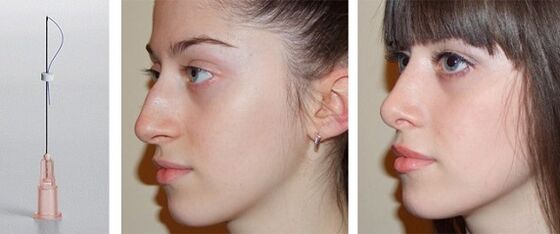
3. Use of mesothreads
With the help of special threads, it is possible to correct the tip of the nose and its wings. The doctor makes small punctures through which he inserts the thread and tightens the nose, giving it the necessary shape. After a few days, the ends of the threads left outside are cut off. The main disadvantage is that scars may remain at the injection sites, which spoil the appearance. Sometimes it happens that the thread inside breaks. But it all depends on the quality of the material and the professionalism of the doctor.
Advantages and disadvantages
Non-surgical rhinoplasty has its pros and cons. The advantages include the following factors:
- speed of carrying out;
- lack of general anesthesia, which can negatively affect the patient's well-being;
- no surgical intervention required;
- the ability to observe the procedure using a mirror;
- the doctor may ask the patient whether this shape of the nose suits him, or if one or another area needs to be slightly corrected;
- lack of a rehabilitation period;
- the ability to go home immediately after the procedure;
- lack of painful sensations;
- plastic in this way is less expensive.
The disadvantages include the following factors:
- fragility of the result obtained (to maintain the effect, you will need to repeat the procedure);
- after the gel has completely resolved, the shape of the nose becomes the same;
- if the plastic is carried out by an inexperienced specialist who inserts the filler incorrectly, then this can lead to the displacement of the gel (the nose will acquire an ugly shape).
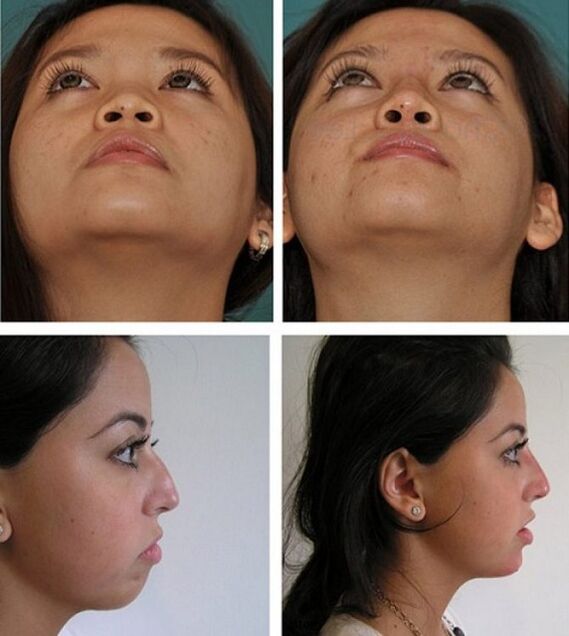
Rehabilitation period
After the nose surgery has been done, doctors recommend minimizing contact with the corrected area. This threatens with displacement of fillers, as a result of which the shape may change.
After the procedure, it is recommended to abandon for a while:
- alcoholic beverages;
- cigarettes;
- prolonged exposure to the sun;
- saunas, swimming pools.
The final result will be noticeable 5-7 days after the procedure.
Side effects
Rhinoplasty without surgery does not cause serious complications. The patient may experience slight swelling, bruising, pain in the nose, which pass very quickly without assistance.
In rare cases, there are such side effects (they can be observed both during the procedure and after it):
- filler displacement;
- breakage of threads;
- problems with the respiratory tract (this mainly happens to those who very often do rhinoplasty for themselves);
- an allergic reaction to the injected drug;
- herpes.
If the patient has been diagnosed with one of the side effects (except for an allergic reaction and herpes), then he is shown a second operation.
Reviews and opinions
People try to find out as much as possible about the chosen procedure, look at photos before and after correction, read reviews. Here's an example of several opinions:
- First review: "Non-surgical plastic surgery became a salvation for my nose, which before that looked" not very beautiful ". I never would have thought that in 15 minutes you can change your appearance like that. I hope that the result will last longer. When the injected drug dissolves, I am ready to repeat the procedure again. "
- Second review: "I am 20 years old. I was persuaded to rhinoplasty by a non-surgical method by my mother, who had been inquiring about her for a long time. Back in school, I severely injured my nose, which affected its appearance. After rhinoplasty, he looked much better. If finances allow, I am ready to repeat it when the effect disappears. "
- Third review: "I found reviews on the Internet about a clinic that deals with plastic surgery. I was attracted by the availability of the services offered. But that was a mistake! The result of the procedure disappointed me. Don't be fooled by the prices! In my case, the saying worked: cheap cheese only in mousetraps. "
- The fourth tip: "After the nose correction, I started to feel a new way. I could not stop looking at my reflection in the mirror. My self-esteem even rose, which had been "limping" since the age of 14, when everyone made fun of the tip of my nose. My tip - I advise you to try and not be afraid. "
- Fifth review: "I have studied the reviews of those who have resorted to non-surgical rhinoplasty for a long time. In most cases, they were positive. Plucking up courage, I went to the clinic. My beloved nose has become not a flaw, but a dignity. My husband really likes the result. "
Summary
Non-surgical plastic is a subject of controversy between specialists. Some of them argue that this method of nose correction is ineffective and it is not worth wasting time. In their opinion, the nose can be changed with the help of surgical rhinoplasty and nothing else. Others insist that the scalpel is "the last century. "But it all depends on the wishes of the patient, who should initially study the features of each procedure, the results, and possible complications.
Comparing non-surgical and classical surgical rhinoplasty, we can only say that each of them has both pros and cons. With the help of the operation, the shape of the nose is changed forever, and a considerable amount of money is spent. It should be borne in mind that the rehabilitation period takes a lot of time. Non-surgical nose correction is a simple and low cost procedure. But its main disadvantage is the fragility of the result obtained.
If the question is about how to change the shape of the nose, then it is important to consider the following factors:
- financial opportunity;
- the presence of contraindications;
- readiness for long-term rehabilitation (if we are talking about a classic operation).
Procedure price
The cost depends on the following factors:
- professionalism of the doctor;
- the credibility of the clinic;
- the need to consult narrow specialists;
- the price of materials;
- the complexity of a particular case.




















